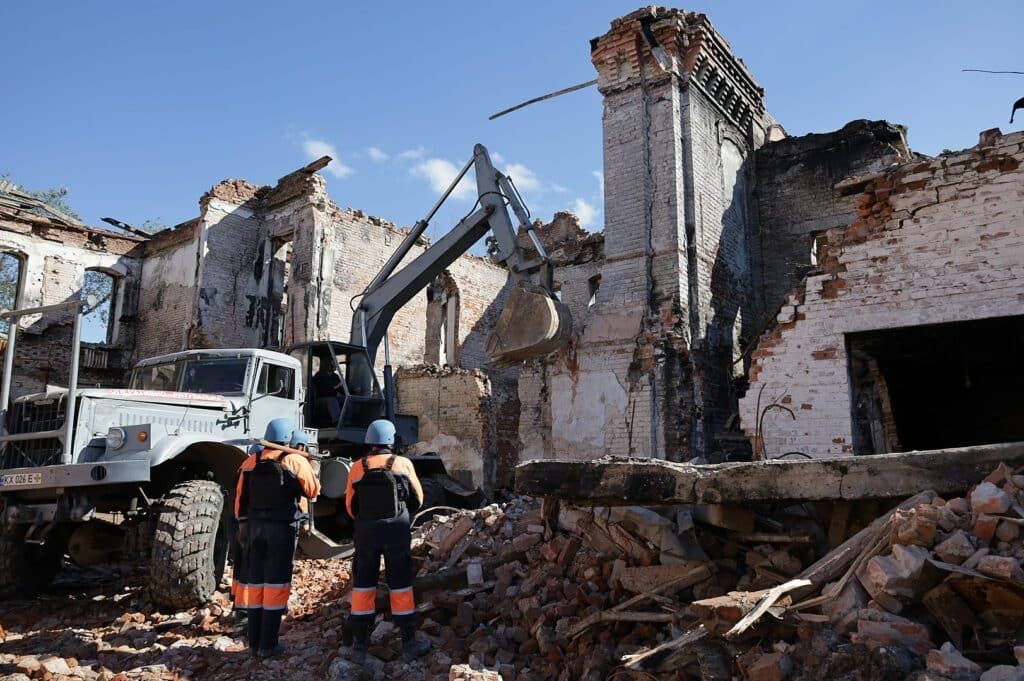A Green Deal for post-war Ukraine
By Anna Ackerman, Nataliya Andrusevych, Oleh Savyskyi | November 1, 2022
 Workers from the State Emergency Service of Ukraine survey damage in Izium, in Kharkiv Oblast. (Photo: Main Directorate of the State Emergency Service of Ukraine in Kharkiv Oblast)
Workers from the State Emergency Service of Ukraine survey damage in Izium, in Kharkiv Oblast. (Photo: Main Directorate of the State Emergency Service of Ukraine in Kharkiv Oblast)
As Russia’s war on Ukraine enters its ninth month, damages to the Ukrainian economy, infrastructure, and environment continue to accumulate. In addition to the human toll—the thousands of Ukrainians killed or injured and the millions displaced—the monetary costs are in the hundreds of billions of dollars and the prospect of attracting substantial foreign investments during wartime looks bleak.
Notwithstanding limited financial and human resources, Ukrainians are already working on reconstruction and development planning. Some of them endured Russian occupation and have begun to physically repair, rebuild, and rehabilitate their communities. Others have welcomed an influx of internally displaced persons who need a place to live, to work, and to take their children to schools. Ukrainians living near the frontline need to ensure their most critical infrastructure is resilient to constant enemy attacks.
Restoring the country and helping communities rebuild will cost a lot, and discussions about how and by whom reconstruction will be funded have already started. On October 25, the German Chancellor Olaf Scholz and the President of the European Commission Ursula von der Leyen chaired the International Expert Conference on the Restoration, Reconstruction and Modernization of Ukraine in Berlin, where President Volodymyr Zelenskyy delivered a keynote speech. The leaders of Germany and the European Union, as well as leading international experts, made it clear that Ukraine needs to make radical changes and fully implement European integration reforms during reconstruction.
Over time, institutional funding and private investments should create a balanced economic development process. As underlined by officials, the process will have to be aligned with accession to the European Union and goals of the European Green Deal, the economic development program to make Europe climate neutral by 2050. With support from the European Union, Ukraine can become an important partner to other member states in achieving that ambition.
Planning for recovery in the midst of war. In April, President Zelenskyy set up the National Council for the Recovery of Ukraine from the Consequences of the War. Later the government presented the vision and basic principles of the recovery during the Conference on Recovery in Lugano, in addition to a draft recovery plan for 24 sectors, including infrastructure, economic recovery, energy security, environmental security, and health. Although the draft plan contains a number of green elements and a separate block on environmental security, it lacks a coherent green vision and cross-cutting elements related to the goals of climate neutrality and decarbonization.
Many active citizens and officials involved in reconstruction planning understand that in rebuilding they should strive to become highly resilient to future crises, ensure advanced protection for the population, and rebuild to the best environmental and efficiency standards simultaneously. To achieve this, a group of more than 50 nongovernmental organizations are advocating for a recovery that prioritizes development of the green economy and integration of environmental and climate policy in all sectors.
The post-war reconstruction of Ukraine is not only about not the rapid reconstruction of destroyed infrastructure, industry, or residential buildings. The post-war recovery will have a significant impact on the country’s development in the medium- and long-term and will determine the direction of development for many years. That is why post-war recovery planning should be green.
This model of reconstruction should aim at building the economy of the future in Ukraine, an economy that grows while its environmental footprint shrinks. In particular, it should support gross domestic product growth decoupled from greenhouse gas emissions. It also needs to have nature protection and citizens’ quality of life at the center of economic development. To enable this the government should develop a solid framework for green investment and innovation.
Security through sustainability. Some Ukrainians have already seen the benefits of sustainable development that predated the war.
Citizens of Slavutych in northern Ukraine were able to charge their electronic devices and stay connected to the outside world during a 30-day Russian occupation, all thanks to a solar photo-voltaic energy cooperative. The city, where most of the workers of the Chornobyl area and the Exclusion Zone live, was cut off from the rest of the country at the beginning of Russia’s full-scale invasion.
The city of Voznesensk in the Mykolaiv region in southern Ukraine started planning for recovery in June. The city saw heavy fighting in early March between Russian occupying forces and the Ukrainian army, which ended with a victory by the latter. After this, Voznesensk welcomed many internally displaced persons, while still being under regular shelling.
As a signatory to the European Covenant of Mayors initiative since 2009, Voznesensk worked on diversification and decarbonization of its energy supply and other climate measures that have been helping the citizens to go through the most challenging and difficult times this year. For example, the municipality invested money in production of solid fuel briquettes. This helped turn organic matter (such as branches from tree pruning) into heat for households. In face of the constant danger of gas and electricity supply disruptions, having locally produced fuel and energy is precious.
Green goals. At the beginning of 2020, Ukraine declared its intentions to be part of the European Green Deal and to contribute to the achievement of climate neutrality. In the pre-war period, a high-level dialogue was established with the European Union on the European Green Deal, and the first attempts were made to include relevant goals and objectives in Ukraine’s strategic planning .
If Ukraine becomes a full-fledged element of the European Green Deal, it will significantly strengthen the current situation in the European Union on a number of issues. For example, the entire agricultural sector of Ukraine, even in its current state, can contribute to ensuring food security and environmental sustainability. For example, the use of pesticides and fertilizers (a cause of significant pressure on the environment) in Ukraine is much lower than the “ambitious” reduction goals set by the European Union
The green model of Ukraine’s post-war recovery requires the support of international partners, primarily the EU, and a fundamental change in their vision of Ukraine’s role and place in the future European and global economy and trade. Building a climate-neutral economy in Ukraine is possible only as part of global efforts to create international green production chains as part of a sustainable global economy.
How the international community can help. International financial institutions and donors involved in the recovery aid in Ukraine should ensure full transparency and accountability by providing access to information and decision-making processes to civil society in line with the Aarhus convention. This is key to prevent manipulations with international funding, which can be misallocated to support private capture of critical infrastructure and unsustainable business practices, such as the expansion of fossil fuel production.
First and foremost, international funding should be directed into decarbonization, local economic resilience, and energy independence, starting from initial stages of recovery of the Ukrainian economy, which is why it’s not too soon to begin planning now. These three pillars of Ukraine’s green and secure future should be guiding motivations for all international aid.
Infrastructure funding must be allocated to establish and build up Ukraine’s domestic capabilities for development of renewable energy technologies, energy efficiency, electrification, and industrial innovation. This can start with green solutions for war relief and immediate humanitarian needs, which can create a basis for further progress in key areas.
For example, providing winterized housing for internally displaced people from European manufacturers of modular net-zero energy buildings can help to establish fast and efficient construction methods and technologies in Ukraine. Starting with humanitarian relief projects and developing into modern social housing programs, such initiatives can help to build new supply chains and establish local manufacturing. This in turn, will enable Ukraine to speed up adoption of net-zero energy building standards and boost progress towards energy and climate goals in the construction sector.
Recovery aid can also be invested in complex solutions for energy efficiency retrofits of depreciated or damaged multi-apartment residential buildings. Once performed and thoroughly documented, retrofit designs and solutions can be scaled to thousands of buildings and dramatically reduce costs through standardization and mass supply chains. If implemented, these housing solutions can create thousands of green jobs, improve social conditions in Ukrainian cities, slash demand for natural gas, and reduce greenhouse gas emissions. And this is only a glimpse of what is possible, if decarbonization is a priority for Ukraine’s economic recovery from day one.
Many more opportunities for creating green jobs and achieving energy security and resilience, higher living standards, and socio-economic benefits can be opened with similar approaches in other key sectors, including power, transportation, and industry.
Today direct links between climate policy, energy security, and geopolitics are hard to deny. Rather than trying to rebuild its Soviet-era infrastructure, severely damaged power sector, and industry, and with broad international support for its economic recovery, Ukraine can create a global showcase of a new decarbonized economy based on renewables, electrification, digital solutions, and industrial innovation.
Together, we make the world safer.
The Bulletin elevates expert voices above the noise. But as an independent nonprofit organization, our operations depend on the support of readers like you. Help us continue to deliver quality journalism that holds leaders accountable. Your support of our work at any level is important. In return, we promise our coverage will be understandable, influential, vigilant, solution-oriented, and fair-minded. Together we can make a difference.
Keywords: Russia-Ukraine, Ukraine, efficiency, energy efficiency, environmental impacts of war, green economy, green energy, sustainability
Topics: Climate Change, Opinion
















